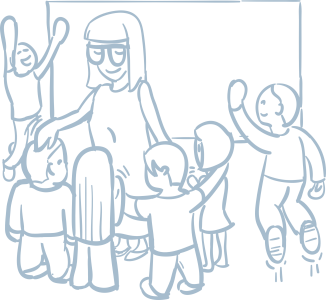The teacher’s role: guiding and mediating discussion
The typecast image of a teacher is that of someone who possesses knowledge and skills, and lectures about them. The mathematics teacher knows mathematics, and can therefore explain mathematics to their students. Often, it really does work like this: the children listen to their teacher’s explanations, write down a few notes, listen to instructions about how to solve a new problem, and learn to use the new procedure. However, in our understanding of the teaching process, the teacher plays a dramatically different role.
The teacher’s role in lessons according to the Hejny teaching method is demanding, but in an entirely different way to that we are used to from traditional teaching.

Advisor rather than authority
The teacher is not a lecturing figure of authority with knowledge and skills. Yes, the teacher does know and can do, but does not demonstrate this in any way. If anyone explains things, it is the pupil. The teacher is in charge of organizing the lessons, encouraging pupils’ work, setting appropriate tasks, sharing the pupils’ joy over their discoveries, and mediating their discussions. He or she also plans and supervises lessons such that each pupil has appropriate work to do. The teacher assigns challenging problems to especially able pupils, and helps less able students to find a problem-solving strategy. He or she is a tacit guide throughout the lesson, but does not assume the lead.
Switching roles
If teachers want to adopt the Hejny method successfully, the adaptation of their own role is among the most difficult changes they must make. It is difficult to get used to the idea that it is the pupils themselves who discuss a problem after it has been presented in class. The pupils will often propose solutions that are unusual, incomplete or even wrong, but it is precisely those moments that are key to the pupils’ future understanding.
Working with error plays a key part here. The teacher does not evaluate individual proposals. He or she turns to the class and asks whether the other pupils agree or not, and why. Pupils thereby learn to analyze both their own and their classmates’ errors. A faulty solution leads them to discover a correct one. They gradually come to draw generalizations from their various mathematical experiences, deepening their knowledge and understanding of mathematics.
The teacher must not use their own knowledge to show pupils a shortcut in their learning process. When that happens, it results in gaps in the pupils’ understanding. These gaps are likely never to be filled, and will fail the pupil in the future. Any shortcut, even one with the best intentions, results in formalism, an illness whose symptom is the pupils’ apparent but temporary knowledge: the pupils only know what the teacher told them, and for as long as they can remember it.
Teacher does not explain
The teacher does not focus on preparing instructions when lesson planning. Instead, they contemplate which problems will most help their pupils to understand. They work with their pupils’ varied levels of ability, knowing that they have some more able, and some less able students in their class. They develop the technique of preparing so-called graded problems, i.e. problems with different levels of complexity, to suit all types of pupils in the class. They learn to complement a textbook problem with both easier and more challenging variations.
